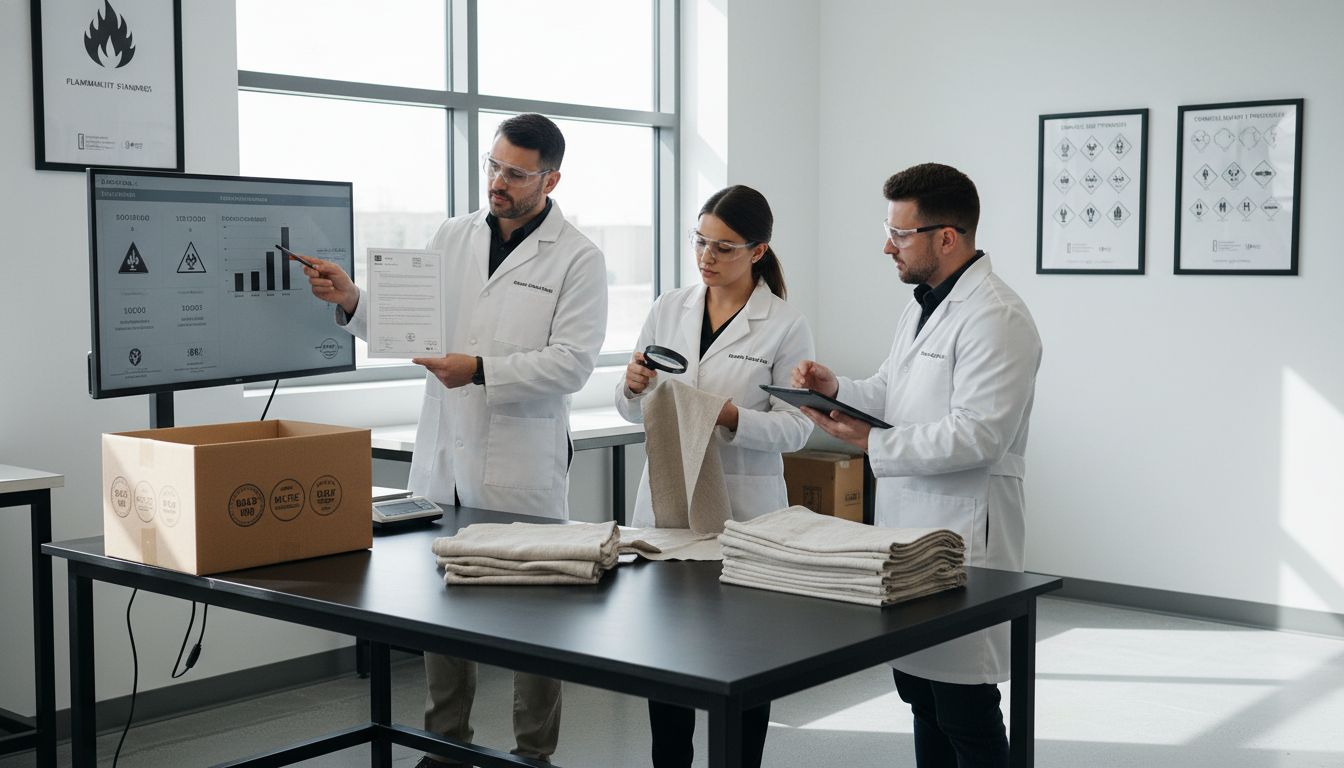Over 75 million people worldwide work in textile production, and their safety depends on clearly defined standards. Linen safety standards guide everything from chemical limits to hygiene practices, shaping safer workplaces and products. Without these guidelines, hidden chemical residues, fire hazards, and health risks could easily reach the hands of unsuspecting consumers. Understanding what shapes these safety measures reveals how every step of the process contributes to quality and well-being.
Table of Contents
- Defining Linen Safety Standards Clearly
- Flammability Regulations And Test Methods
- Chemical And Certification Requirements
- Safe Laundering And Hygiene Practices
- Handling Risks And Compliance Responsibilities
Key Takeaways
| Point | Details |
|---|---|
| Safety Standards Framework | Textile safety standards protect consumers, workers, and the environment by addressing chemical safety, worker protection, and product quality. |
| Flammability Regulations | Compliance with flammability standards is essential to prevent fire hazards in textiles, ensuring rigorous testing of fabric ignition and combustion characteristics. |
| Chemical Certification Importance | Chemical safety certifications are crucial for tracking harmful substances in textiles and ensuring products meet rigorous safety criteria. |
| Risk Management Responsibilities | Effective risk management in textiles involves thorough risk assessments, documentation, training, and regular inspections to ensure safety and compliance. |
Defining Linen Safety Standards Clearly
Safety standards in textiles are more than just bureaucratic checklists. They represent a critical framework protecting consumers, workers, and the environment throughout the entire textile production process. According to the International Labour Organization (ILO), comprehensive safety guidelines help eliminate, reduce, and control major hazards in textile manufacturing.
In practical terms, linen safety standards cover multiple critical dimensions:
- Chemical Safety: Regulating harmful substances like formaldehyde and ensuring textiles are free from toxic residues
- Worker Protection: Establishing guidelines for safe working conditions and minimizing occupational health risks
- Product Quality: Maintaining rigorous testing protocols for durability, colorfastness, and potential allergen exposure
The Occupational Safety and Health Administration (OSHA) provides specific regulations addressing air contaminants, cotton dust exposure, and chemical safety in textile production. These standards aren’t just theoretical guidelines but practical measures designed to protect everyone involved in the textile supply chain.
Ultimately, safety standards represent a commitment to transparency, health, and responsible manufacturing. They ensure that when you wrap yourself in a soft linen robe or towel, you’re experiencing not just comfort, but a product crafted with meticulous attention to human and environmental well-being.
Here’s a summary of main linen safety standards and their focus areas:
| Standard/Regulation | Main Focus | Examples/Certifications |
|---|---|---|
| Chemical Safety | Harmful substance control | Formaldehyde restrictions Oeko-Tex Standard 100 |
| Worker Protection | Safe work environments | OSHA guidelines ILO regulations |
| Product Quality | Performance & allergen safety | Durability tests Colorfastness protocols |
| Flammability Regulations | Fire hazard prevention | CPSC standards Vertical/Horizontal flame tests |
| Hygiene & Laundering | Infection prevention & sanitation | AHE recommendations Healthcare Laundry Accreditation |
| Compliance & Risk Management | Documentation & training | Risk assessments Regular inspections |
Flammability Regulations And Test Methods
Flammability regulations play a critical role in consumer safety, particularly in textile manufacturing. According to the Consumer Product Safety Commission (CPSC), specific standards are designed to prevent dangerously flammable garments from entering commercial markets, protecting consumers from potential fire hazards.
The standard test methods for evaluating textile flammability typically involve rigorous assessment protocols:
- Vertical Flame Test: Measuring how quickly fabric ignites and how rapidly flames spread
- Horizontal Flame Test: Analyzing fabric’s resistance to horizontal flame propagation
- Burn Rate Analysis: Calculating the speed and extent of fabric combustion under controlled conditions
OSHA’s textile industry standards complement these tests by addressing additional hazardous substance considerations that might influence a textile’s flammability characteristics. These regulations ensure that manufacturers implement comprehensive safety measures throughout the production process.
For consumers and manufacturers alike, understanding flammability standards means more than just compliance. It represents a commitment to safety, protecting individuals from potential fire-related risks while ensuring textiles meet stringent quality and performance benchmarks. From children’s sleepwear to industrial workwear, these regulations serve as a critical protective framework in textile design and production.
Chemical And Certification Requirements
Chemical safety in textiles goes far beyond simple manufacturing protocols. According to Oeko-Tex, comprehensive certification systems are crucial for ensuring that textile products remain free from potentially harmful substances throughout their entire production lifecycle.
The certification landscape for textile safety includes several key standards:
- Standard 100 Certification: Rigorous testing for potentially dangerous chemicals
- Restricted Substances List (RSL): Identifying and limiting hazardous chemical concentrations
- Supply Chain Transparency: Tracking chemical usage from raw material to finished product
- Ecological Impact Assessment: Evaluating environmental consequences of chemical treatments
Linen service providers like HLS Linen Services demonstrate the importance of professional accreditation, adhering to ISO 9001 standards and maintaining Healthcare Laundry Accreditation Council (HLAC) certification. These credentials ensure not just chemical safety, but comprehensive quality management across textile processing.
For consumers and manufacturers, understanding chemical certification means recognizing that every thread tells a story of safety, sustainability, and responsible production. It’s about protecting health, preserving environmental integrity, and ensuring that the textiles we use daily meet the highest standards of chemical safety and quality.
Safe Laundering And Hygiene Practices
Hygienic laundering is far more than a simple cleaning process. According to The Joint Commission, developing evidence-based protocols is critical for maintaining textile safety and preventing potential cross-contamination in various environments.
Key principles for safe laundering include:
- Temperature Control: Using appropriate water temperatures to eliminate microorganisms
- Detergent Selection: Choosing chemicals that effectively sanitize without damaging fabric
- Separation Protocols: Keeping different types of textiles segregated during washing
- Drying Procedures: Ensuring complete moisture removal to prevent bacterial growth
The Association for the Health Care Environment (AHE) emphasizes the importance of professional training in linen management. Their courses highlight critical aspects of infection prevention, teaching professionals how to handle textiles in ways that minimize health risks.
Ultimately, safe laundering is about more than clean linens. It’s a comprehensive approach to health protection, requiring careful attention to scientific protocols, understanding fabric characteristics, and maintaining stringent hygiene standards across all textile handling processes.

Handling Risks And Compliance Responsibilities
Risk management in the textile industry is a comprehensive approach that involves multiple stakeholders. According to the International Labour Organization (ILO), creating a preventative safety and health culture requires collaborative efforts from governments, employers, and workers to effectively manage potential hazards.
Key compliance responsibilities typically include:
- Risk Assessment: Systematically identifying and evaluating potential workplace hazards
- Documentation: Maintaining detailed records of safety protocols and incident reports
- Training Programs: Implementing comprehensive safety education for all personnel
- Regular Inspections: Conducting periodic evaluations of workplace safety conditions
OSHA’s textile industry standards provide critical guidance on addressing specific risks, including regulations on air contaminants and hazardous substances. These standards serve as a comprehensive framework for ensuring worker safety and maintaining high-quality production environments.
Ultimately, handling risks is more than a legal obligation. It’s a moral commitment to protecting human health, ensuring workplace dignity, and creating a culture of safety that extends from manufacturing floors to the final consumer. Compliance isn’t just about following rules it’s about creating environments where people and products can thrive safely and responsibly.
Experience Linen Safety and Comfort Like Never Before
The article outlines key challenges like chemical safety, flammability regulations, and hygienic laundering that ensure linens protect your health and environment. At Lotus Linen we understand how critical it is to have bath and loungewear that meets these rigorous safety standards while delivering unmatched comfort and style. When you choose our plush and waffle robes for men women kids and families you are choosing products crafted with the same commitment to worker protection chemical safety and hygienic textiles highlighted by industry experts.

Discover the peace of mind that comes with linens designed to meet strong safety protocols and bring luxurious softness to your daily routine. Visit Lotus Linen today and explore our customizable robes and spa accessories that prioritize your well-being without compromising on aesthetic elegance. Take the step now to protect your health and indulge in safe comfort by shopping at https://shoplotuslinen.com. The time to enjoy safe and stylish linens is now.
Frequently Asked Questions
What are linen safety standards?
Linen safety standards are guidelines and regulations that ensure the protection of consumers, workers, and the environment throughout the textile production process. They cover aspects like chemical safety, worker protection, product quality, and hygiene practices.
How do chemical safety standards affect textile production?
Chemical safety standards regulate the use of harmful substances in textiles, ensuring that products are free from toxic residues and that chemicals are used responsibly throughout the manufacturing process.
What are the key testing methods for evaluating textile flammability?
The primary testing methods for assessing textile flammability include the vertical flame test, horizontal flame test, and burn rate analysis, measuring how fabrics ignite and burn under controlled conditions.
Why is proper laundering important for linen safety?
Proper laundering is crucial for maintaining linen safety as it helps eliminate microorganisms, prevents cross-contamination, and ensures that textiles are sanitized, thus protecting users’ health.
